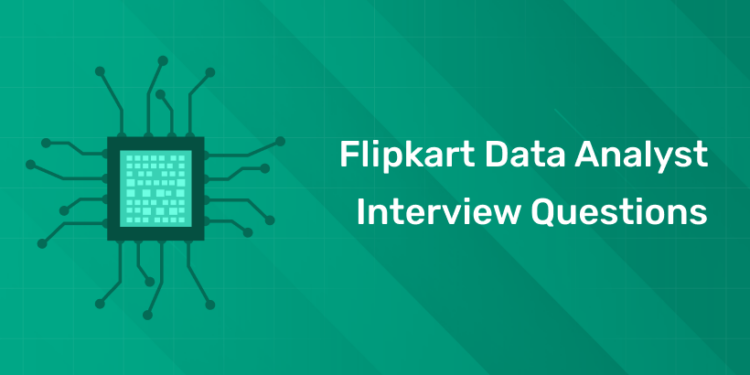Flipkart’s data analyst interviews are known for their rigor and competitiveness. Candidates must possess strong analytical skills. Mastery in SQL and Python is essential. You’ll face questions on data cleaning and manipulation. Proficiency in statistical analysis and a solid understanding of business metrics is a must. Expect to encounter behavioral questions as well. Problem-solving abilities are highly valued. Read this blog for Flipkart Data Analyst Interview Questions.
Click here to ace Fipkart Data Science Interview Questions by learning the fundamentals!
Flipkart Data Analyst Interview Questions
Flipkart is one of India’s leading e-commerce companies, founded in 2007. Initially an online bookstore, it has expanded to offer a wide range of products, including electronics, fashion, and groceries. Flipkart has become a key player in the Indian retail market, known for its customer-centric approach, innovative technology, and large-scale sales events like Big Billion Days. The company has significantly influenced India’s digital commerce landscape.
Why Join in Flipkart?
Here is why you should join this prestigious company:
1. Exciting Work Environment
Flipkart offers an exciting and fast-paced work environment. The company encourages creativity and innovation. Employees take charge of their projects. This environment helps you grow and learn continuously. It’s great for those seeking challenging and rewarding work.
2. Meaningful Work
At Flipkart, your work impacts millions of users daily. The company plays a big role in e-commerce. You’ll work on projects that boost business growth. This gives a strong sense of purpose. Your work here truly makes a difference.
3. Career Growth
Flipkart focuses on helping employees grow and develop. The company offers various training and mentorship programs. These programs enhance your skills and career prospects. There are many chances for promotions and leadership roles. Flipkart supports your career at every step.
4. Inclusive Culture
Flipkart values diversity and inclusion in the workplace. The company welcomes different perspectives and open communication. This approach creates a supportive work environment. Employees feel valued and respected here. Everyone has the opportunity to succeed.
5. Great Pay and Benefits
Flipkart provides competitive salaries and excellent benefits. These include health insurance, retirement plans, and wellness programs. The company also offers bonuses and stock options. Hard work is rewarded well at Flipkart. These benefits support a good work-life balance.
6. Focus on Innovation
Flipkart is a leader in e-commerce innovation. The company works with cutting-edge technology. You’ll be part of exciting tech projects. Flipkart is a great place for technology enthusiasts. It’s where new ideas and solutions are created.
7. Social Responsibility
Flipkart is committed to helping society. The company supports education, healthcare, and the environment. Employees can join in these meaningful initiatives. Working here lets you give back to the community. It’s a place where you can make a positive impact.
Flipkart Interview Preparation Tips
Follow the tips given below to succeed in the interview:
1. Understand the Role
Research the job to fully grasp what the role involves. Read the description carefully to understand the main tasks expected. Match your skills and experience with the job requirements. Identify key skills that are essential for success in this role. Clarify expectations by understanding what Flipkart looks for in candidates.
2. Strengthen Technical Skills
Begin by learning the basics of SQL for database querying. Practice Python, focusing on data manipulation and analysis tasks. Review your Excel skills, especially in formulas and data analysis. Study common data structures and algorithms to enhance your knowledge. Work on real problems using datasets and coding challenges to gain experience.
3. Prepare for Behavioral Questions
Use the STAR method to structure your answers effectively. Highlight specific past successes that are relevant to the role. Practice responses to common scenarios involving teamwork and leadership. Be honest and reflective when discussing what you learned from experiences. Prepare stories and examples for typical behavioral questions you may encounter.
4. Focus on Data Interpretation
Practice analyzing sample data using publicly available datasets. Understand how to interpret data within a business context effectively. Get comfortable explaining visual data, like charts and graphs. Work on case studies that involve making data-driven decisions. Review and familiarize yourself with analytics tools like Tableau.
5. Practice with Mock Interviews
Role-play interviews with a friend or mentor to simulate real conditions. Dress up and treat the practice as if it were an actual interview. Record yourself to identify areas where you can improve responses. Seek honest feedback from others to refine and clarify your answers. Focus on making your responses clearer and more concise.
6. Research Flipkart
Understand Flipkart’s history and its journey to success. Study the market to learn about Flipkart’s main competitors. Stay updated on the latest news and recent projects at Flipkart. Familiarize yourself with the range of products Flipkart offers to customers. Learn about the company’s values and what Flipkart stands for.
7. Prepare Your Questions
Ask about team dynamics and the structure of the team. Discuss opportunities for career growth, training, and promotion within the company. Understand the work culture, including the work-life balance at Flipkart. Clarify job duties to know the day-to-day responsibilities involved. Show interest in overcoming challenges that the role might present.
8. Stay Calm and Confident
Practice deep breathing exercises to calm yourself before the interview. Answer questions clearly, keeping your responses short and concise. Maintain eye contact during the interview to show confidence. Speak slowly to avoid rushing through your answers unnecessarily. Stay positive, approaching each question with a can-do attitude.
Click here to ace Flipkart Data Science Interview Questions by learning the fundamentals!
Top Flipkart Data Analyst Interview Questions and Answers
1. SQL and Database Questions
- What is a Primary Key?
- A Primary Key uniquely identifies records in a table.
- It prevents duplicate values within the column.
- A table can only have one Primary Key.
- The Primary Key column cannot contain NULL values.
- It ensures data integrity in the database.
- Explain the concept of Foreign Key.
- A Foreign Key links two tables in a database.
- It references the Primary Key of another table.
- Ensures consistency and prevents invalid data entries.
- Helps maintain relationships between different tables.
- Prevents orphaned records in related tables.
- What are the different types of SQL joins?
- INNER JOIN returns only matching records from both tables.
- LEFT JOIN returns all records from the left table.
- RIGHT JOIN returns all records from the right table.
- FULL JOIN returns all records from both tables.
- Joins help combine data from multiple tables.
- What is the difference between GROUP BY and ORDER BY?
- GROUP BY groups data based on a specific column.
- It’s used with aggregate functions like SUM or COUNT.
- ORDER BY sorts the data in ascending or descending order.
- GROUP BY organizes data, while ORDER BY sorts it.
- Both help in presenting data in a useful way.
- What are aggregate functions in SQL? Provide examples.
- Aggregate functions perform calculations on multiple rows.
- Examples include SUM(), COUNT(), AVG(), MIN(), and MAX().
- SUM() adds values, while COUNT() counts rows.
- AVG() calculates the average of values in a column.
- Used to summarize and analyze data.
2. Excel and Data Visualization Questions
- How do you handle missing data in Excel?
- Remove rows with missing data if they’re not important.
- Use
IFfunctions to identify missing data. - Replace missing values with mean or median.
- Use Excel’s “Find and Replace” feature to handle gaps.
- Missing data must be handled to ensure accurate analysis.
- Explain VLOOKUP in Excel.
- VLOOKUP searches for a value in a vertical column.
- It returns a matching value from another column.
- It is useful for retrieving data across multiple sheets.
- The syntax is =VLOOKUP(value, table, column, range).
- It simplifies finding related data in large datasets.
- What are Pivot Tables, and how are they useful?
- Pivot Tables summarize large datasets in Excel.
- They organize data based on categories for analysis.
- Can calculate sums, averages, or counts of data.
- Useful for reporting and understanding trends.
- Flexible for filtering and sorting data.
- What are the different chart types in Excel?
- Bar charts compare categories or groups of data.
- Pie charts show proportions or parts of a whole.
- Line charts display data trends over time.
- Scatter plots show relationships between two variables.
- Choosing the right chart improves data interpretation.
- How do you use conditional formatting in Excel?
- Conditional Formatting highlights cells based on rules.
- Apply formatting like colors or bold text for specific conditions.
- Helps identify trends, outliers, or patterns in data.
- Simplifies the visual interpretation of data.
- It’s useful for spotting key values quickly.
3. Python and Data Analysis Questions
- What are Python libraries used for data analysis?
- Pandas for data manipulation and handling DataFrames.
- NumPy for performing numerical operations on arrays.
- Matplotlib for visualizing data with graphs and charts.
- Seaborn for statistical data visualization.
- SciPy for advanced mathematical functions and operations.
- Explain the concept of a DataFrame in Pandas.
- A DataFrame is a two-dimensional table of data.
- It stores data in rows and columns like Excel.
- Each column can hold different data types.
- Allows easy manipulation, filtering, and sorting of data.
- Useful for handling large datasets.
- What are NumPy arrays, and how are they different from lists?
- NumPy arrays store elements of the same type.
- Lists can contain elements of different types.
- Arrays are more memory-efficient and faster for calculations.
- NumPy arrays support vectorized operations.
- Lists are more flexible but slower in large operations.
- How would you handle missing values in Pandas?
- Use dropna() to remove rows with missing values.
- Replace missing values using fillna() with mean or median.
- Use forward fill for time series data.
- Analyze why data is missing before handling it.
- Pandas offers flexible methods for missing data.
- What is the difference between loc[ ] and iloc[ ]in Pandas?
- loc[ ] is label-based indexing (by row or column names).
- iloc[ ] is integer-based indexing (by row/column positions).
- loc[ ] is used with row and column labels.
- iloc[ ]is useful for selecting data by position.
- Both methods access rows and columns in DataFrames.
4. Statistical Concepts
- What is the difference between variance and standard deviation?
- Variance measures how data points differ from the mean.
- Standard deviation is the square root of variance.
- Variance is measured in squared units.
- Standard deviation is easier to interpret.
- Both show how spread out the data is.
- What is p-value in hypothesis testing?
- P-value shows the evidence against the null hypothesis.
- Lower p-value means stronger evidence to reject the hypothesis.
- P-value below 0.05 is considered statistically significant.
- Helps decide if results are due to chance.
- Used in making decisions during tests.
- What is correlation, and how is it different from causation?
- Correlation measures the relationship between two variables.
- Causation implies one variable causes changes in another.
- Correlation does not imply causation.
- Correlation is measured between -1 and 1.
- Used to study associations between variables.
- What is the Central Limit Theorem?
- Sample means approach normal distribution as sample size increases.
- Holds true regardless of population distribution shape.
- Used in inferential statistics for hypothesis testing.
- Larger sample sizes produce more accurate means.
- Basis for using normal distribution in analysis.
- Explain the concept of confidence intervals.
- A confidence interval estimates the population parameter range.
- A 95% confidence interval means 95% chance the value lies inside.
- It reflects the uncertainty of the estimate.
- Wider intervals indicate more variability in data.
- Commonly used in reporting experimental results.
5. Machine Learning and Data Science Questions
- What is supervised learning?
- Supervised learning uses labeled data to train models.
- It predicts outcomes based on known input-output pairs.
- Examples include classification and regression models.
- Supervised learning needs both input features and target labels.
- Models learn patterns and apply them to new data.
- What is unsupervised learning?
- Unsupervised learning uses unlabeled data to find patterns.
- No explicit target values are provided during training.
- Clustering and association are common unsupervised techniques.
- It helps discover hidden patterns in data.
- It groups data without prior knowledge of categories.
- Explain the difference between classification and regression.
- Classification predicts categorical outcomes (e.g., yes/no).
- Regression predicts continuous outcomes (e.g., house prices).
- Classification assigns data to distinct categories.
- Regression models relationships between variables to predict values.
- Both are types of supervised learning.
- What is overfitting, and how can it be avoided?
- Overfitting occurs when a model performs well on training data.
- It performs poorly on new, unseen data.
- Use cross-validation to assess model performance.
- Regularization techniques like Lasso or Ridge can prevent overfitting.
- Simplifying models reduces overfitting risk.
- What is the purpose of cross-validation?
- Cross-validation tests model performance on different data subsets.
- It divides data into training and testing parts.
- It helps detect overfitting and ensures generalization.
- Common methods include k-fold cross-validation.
- It gives a more reliable evaluation of the model.
6. Data Interpretation and Problem-Solving Questions
- What steps do you follow in solving a data problem?
- Understand the problem requirements clearly.
- Gather and explore the relevant data.
- Clean the data and handle missing values.
- Apply appropriate analysis techniques or algorithms.
- Present results using visualizations or reports.
- How do you deal with outliers in data?
- Identify outliers using statistical methods (e.g., z-scores).
- Remove outliers if they distort the analysis.
- Apply transformations to reduce outlier influence.
- Replace outliers with median or mean values.
- Analyze if outliers represent valid data points.
- How would you prioritize data analysis tasks in a project?
- Start with understanding business objectives.
- Identify high-impact data points and features.
- Focus on tasks that affect decision-making.
- Break down complex tasks into manageable steps.
- Regularly reassess and adjust priorities.
- Explain A/B testing in data analysis.
- A/B testing compares two versions (A and B).
- It helps determine which version performs better.
- Commonly used in web or product optimizations.
- One version acts as a control group.
- Results are compared using statistical tests.
- How do you ensure data accuracy?
- Double-check data sources for reliability.
- Validate data with reference standards.
- Use consistency checks to find anomalies.
- Regularly audit data for correctness.
- Automate data validation where possible.
7. Data Cleaning and Preprocessing
- What is data cleaning, and why is it important?
- Data cleaning removes errors, inconsistencies, or inaccuracies.
- It ensures data quality before analysis.
- Involves handling missing, duplicated, or incorrect data.
- Clean data leads to better model performance.
- It prevents bias in analysis results.
- How do you handle missing data in a dataset?
- Remove rows with missing values if appropriate.
- Fill missing values with mean, median, or mode.
- Use forward or backward fill for time series data.
- Use predictive modeling to estimate missing values.
- Analyze why data is missing before deciding.
- What are the common methods for detecting outliers?
- Use statistical methods like z-scores or IQR.
- Visualize data with box plots or scatter plots.
- Identify outliers using distance-based techniques.
- Review domain knowledge to understand anomalies.
- Outliers may indicate data errors or interesting patterns.
- Explain the concept of data normalization.
- Data normalization scales features to a common range.
- It helps models perform better by reducing data variance.
- Methods include min-max scaling and z-score normalization.
- Normalization ensures no single feature dominates.
- It is essential for distance-based algorithms.
- What is feature engineering?
- Feature engineering creates new variables from existing data.
- It improves model performance and accuracy.
- Methods include binning, combining features, or creating interactions.
- Domain knowledge is key in crafting relevant features.
- It helps extract meaningful information for the model.
8. Data Visualization and Reporting
- Why is data visualization important in data analysis?
- Visualization makes data easier to understand.
- It highlights patterns, trends, and insights clearly.
- Visuals communicate findings more effectively.
- It simplifies decision-making for stakeholders.
- Helps detect outliers or issues in the data.
- What are some commonly used data visualization tools?
- Excel for basic charts and tables.
- Tableau for interactive and detailed dashboards.
- Power BI for business reporting.
- Matplotlib and Seaborn in Python for custom graphs.
- Google Data Studio for web-based visualizations.
- What is the difference between bar charts and histograms?
- Bar charts compare categorical data across different groups.
- Histograms show the distribution of continuous data.
- Bar charts have spaces between bars.
- Histograms have no gaps between bars.
- Both help visualize data distributions.
- Explain the purpose of a scatter plot.
- Scatter plots show relationships between two variables.
- Each point represents an observation in the dataset.
- It helps identify correlations or patterns.
- Ideal for visualizing continuous data.
- Useful for regression analysis.
- What is a heatmap, and when is it used?
- A heatmap uses color to represent data values.
- It highlights patterns across two dimensions.
- Used to visualize correlation matrices or large datasets.
- Color gradients represent different data intensities.
- Effective for showing large-scale trends.
9. Advanced Data Concepts
- What is dimensionality reduction?
- Dimensionality reduction simplifies datasets by reducing feature numbers.
- It eliminates redundant or irrelevant features.
- Methods include PCA (Principal Component Analysis).
- It improves model performance and speeds up processing.
- Useful when working with large datasets.
- Explain the concept of feature selection.
- Feature selection chooses important features for model training.
- It reduces overfitting and improves model accuracy.
- Methods include filter, wrapper, and embedded techniques.
- It removes irrelevant or redundant data.
- Saves computational time and resources.
- What is multicollinearity, and how can it affect models?
- Multicollinearity occurs when independent variables are highly correlated.
- It causes problems in regression models by inflating coefficients.
- Detected using correlation matrices or VIF (Variance Inflation Factor).
- It reduces the interpretability of the model.
- Can be managed by removing one of the correlated variables.
- Explain the concept of regularization in machine learning.
- Regularization prevents overfitting in machine learning models.
- It adds a penalty for complex models.
- Lasso and Ridge are common regularization techniques.
- Regularization keeps the model simple and generalizable.
- It helps balance bias and variance.
- What is time series analysis?
- Time series analysis studies data points over time intervals.
- It detects trends, seasonal patterns, and cyclical behaviors.
- Models like ARIMA and SARIMA predict future values.
- Important in forecasting and trend analysis.
- Time-based data requires specific handling techniques.
10. Flipkart-Specific and Business-Oriented Questions
- What do you know about Flipkart’s data analytics operations?
- Flipkart uses data for customer behavior analysis.
- Data helps in improving logistics and delivery processes.
- They use data to optimize product recommendations.
- Analytics plays a role in pricing strategies and promotions.
- Data-driven decisions are key to Flipkart’s success.
- How would you improve customer retention using data analytics?
- Analyze customer behavior to identify churn risks.
- Offer personalized promotions to retain customers.
- Track customer satisfaction through surveys and feedback.
- Use data to improve delivery speed and convenience.
- Monitor trends in purchase frequency.
- How can data help optimize Flipkart’s supply chain?
- Data helps track inventory and demand patterns.
- It identifies bottlenecks in the supply chain process.
- Analytics predict demand spikes and optimize stock levels.
- Data improves delivery routing and minimizes delays.
- Efficient supply chain management reduces costs.
- Explain how data analytics can be used for pricing strategy.
- Monitor competitor prices and adjust accordingly.
- Track customer buying behavior and price sensitivity.
- Use data to run pricing experiments and A/B tests.
- Analytics helps find optimal pricing for profitability.
- Dynamic pricing models can maximize revenue.
- What metrics would you track to measure Flipkart’s business performance?
- Track revenue growth and profit margins.
- Monitor customer acquisition and retention rates.
- Analyze website traffic and conversion rates.
- Measure average order value and repeat purchases.
- Assess delivery times and customer satisfaction scores.
Click here to ace Flipkart Data Science Interview Questions by learning the fundamentals!
Flipkart Data Analyst Interview Questions: Conclusion
Given in this blog are some Flipkart Data Analyst Interview Questions. Preparing for a Flipkart Data Analyst interview requires focused practice. Review common questions on data analysis concepts. Strengthen your skills in SQL, Excel, and Python. Practice solving real-world problems through case studies. This approach will boost your confidence and readiness. Candidates can use the above questions for their preparation. All the best for your interview!
🚀 Start Coding Today! Enroll Now with Easy EMI Options. 💳✨
Equip yourself with in-demand skills to land top-tier roles in the data-driven world.
Start Learning Now with EMI OptionsFrequently Asked Questions
What types of technical questions are asked in a Flipkart Data Analyst interview?
Technical questions often focus on SQL queries, data manipulation, and statistical analysis. Expect questions on joining tables, writing complex queries, and using functions to analyze data. Knowledge of Python or R for data analysis might also be tested.
How does Flipkart assess a candidate’s problem-solving skills during the interview?
Flipkart typically presents real-world business problems and asks candidates to analyze data and derive insights. They may give a dataset and ask how you would clean, analyze, and present it to solve a specific problem.
What should I focus on while preparing for the data interpretation section of the interview?
Focus on understanding key metrics like sales trends, customer behavior, and inventory management. You may be asked to interpret graphs, charts, or data summaries to make informed decisions or identify patterns.
What soft skills are important for a Data Analyst role at Flipkart?
Communication skills are crucial, as you’ll need to explain complex data insights to non-technical stakeholders. Problem-solving, critical thinking, and the ability to work in teams are also highly valued.
How does Flipkart evaluate a candidate's knowledge of e-commerce during the interview?
You might be asked to analyze data specific to e-commerce, like customer retention, purchase behavior, or inventory management. Understanding key e-commerce metrics and how they impact business decisions at Flipkart is essential.













